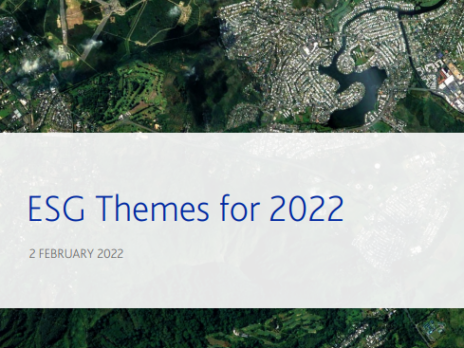

As urgency around the climate crisis heightens, the world is seeing a greater call for accountability and transparency. Market and investor pressure is mounting on the private sector to transition to a low-carbon economy, making corporate ESG disclosures a critical piece of the puzzle.
Vague claims around sustainability will not pass muster with investors and regulators. Rather, they are calling for precise data around companies’ ESG impacts, be that in the form of understanding nature-related risk, biodiversity loss, human rights considerations or other ESG factors.
“The single biggest challenge for our customers is accessing information around climate risks and opportunities that they are comfortable with,” says Julia Haake, managing director, market strategy, at Moody’s ESG Solutions. “As the market becomes more sophisticated, practitioners want to be sure the information they are getting is reliable.”
Moody’s ESG Solutions, which was established in 2020, has clients across the financial spectrum: corporations, banks, insurance companies, capital allocators and portfolio managers. Many are now looking to monitor ESG risk proactively, whether to demonstrate their corporate values or get a step ahead of future regulations.
“Depending on their role as either a company or as an asset manager, they also want to engage in stewardship,” says Haake. “They want to engage with either their supply chain or with their investees, and they want to do that knowing as much as possible about where each group stands in terms of their ESG performance.”
She adds that, over the past few years, ESG and climate-related issues have come to be seen as a relevant and specialty risk class. The launch of Moody’s ESG Solutions reflects and serves the growing market demand for more specific, accurate and transparent ESG insights that consider not only how ESG and climate considerations affect company performance, but also how a company’s operations impact a broad range of stakeholders, from the environment, to employees, to society at large. This so-called ‘double materiality’ approach lies at the heart of Moody’s ESG Solutions’ offering.
“When the market started approaching us saying, could you move into this arena, what they were really saying was, ‘can you bring order to the chaos?’” says Haake. “We’ve gone back to basics. We are clearly defining every data point and creating our ESG Assessment methodologies in a completely transparent way, specific to a sector to reflect sector materiality.”
A comprehensive view of risk
To understand the short- and long-term impact of ESG and climate exposures, market participants need a full and reliable view of risks and opportunities. This is where Moody’s comprehensive offering comes in. A new platform, Moody’s ESG360, provides portfolio managers with access to physical and climate risk data on 10,000 companies globally. Going forward, the platform will be enhanced to include coverage of 300 million public and private companies through a combination of modelled and ESG analyst-verified scores, allowing portfolio managers to identify leaders and laggards in a given region or sector.
“If you’re a financial institution you need that holistic view of risk, covering large corporates, SMEs, commercial real estate, and mortgage-backed securities,” says Haake. “We’re creating data that can be applied to the whole portfolio, as well as at the entity level. And all on a single platform.”
Clearly, a solution of this nature involves enormous quantities of data. For the time being, the challenge is that corporates – SMEs in particular – are not disclosing very much, impacting data quality and company coverage. To help overcome this issue, Moody’s deploys AI and machine learning, in addition to collecting data through analyst verification and validation.
“We take a statistically relevant sample set and use predictive analytics to score private companies globally. This provides financial institutions with essential data for portfolio and risk management, and helps companies monitor ESG risk across their global supply chains,” says Haake. “As company disclosures get better, the precision of the scores will improve, and, in time, they can be tied to financial performance.”
Rather than pretending there are disclosures where there aren’t any, Moody’s gives its customers the most reliable information available, while highlighting any gaps.
“Granular, clear data labels are essential,” says Haake. “We clearly label whether a metric or a data point has been predicted, verified or validated.”
Closing the data gaps
Data collection is tricky, even where companies are disclosing, they aren’t doing so in a standardised way. Company policies can range from the vague (“everybody should be treated equally”), to the specific (“we are targeting an X% increase in women in leadership roles by 2025”), to the abstract or even pictorial. This is where Moody’s technology-enabled analysis comes in.
“We use machine learning to perform the data extraction,” explains Haake. “Then we have levels of quality assurance, so that we can verify that what we picked up was what we meant to pick up, and then we can put it through standardisation scripts to make sure it gets converted to a common unit. Finally, you need to put it through analyst validation, because when you’re talking company disclosures, the question is, is this good or bad relative to others and normative standards?”
The goal is to establish a common standard that can be used throughout the industry, no matter what the customer’s use cases are and what reporting requirements they are facing. Whether the customer is a corporate, a capital allocator or a financial institution, they need objective information in order to take a view of performance, risk and financial implications.
In the meantime, Moody’s is engaging closely with regulators and policymakers to help the market establish the appropriate ESG disclosures.
As well as the aforementioned Moody’s ESG360, the company has also launched a corporate engagement platform, Moody’s ESG360 Connect, which enables companies to engage with Moody’s directly and ensure their data and ESG performance is being represented accurately. Over time, this platform will help Moody’s improve the calibre of the information that’s being placed in front of the investor.
“We’re taking a very Moody’s approach, which is bringing rigour and deliberate execution to establishing standards in this arena,” says Haake. “What it really boils down to is, do our customers have the information that they need to get the job done?”







